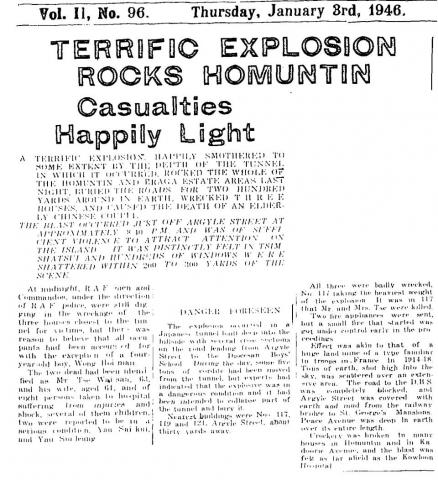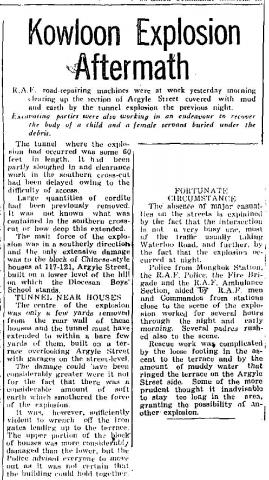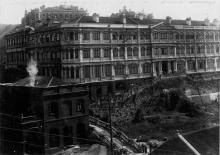Japanese tunnels, Diocesan Boys School [????- ]
Primary tabs
These tunnels were the center of attention in early 1946 - when they exploded!
The tunnels were dug into the slope on the southern edge of the Diocesan Boys School (DBS) campus, near to Argyle Street. The tunnels would have been well known to the school at the time, as the school staff had been pressed into digging the tunnels by the Japanese. The DBS website notes:
The school was occupied by the Japanese in the year 1941. Most of the personnel (including Mr. Goodban and the staff) at school were jailed and made to dig an underground chamber to store the ammunition of the Japanese. The building itself was transformed into a military hospital (Kempi Tai to serve the Japanese soldiers).
It might seem strange to store large quantities of explosives near to a hospital, but maybe they thought the area would be less likely to be bombed during air raids?
After the war, an immeadiate task for the returning British forces was to make safe the explosives and ammunition left behind by the Japanese. They knew of this tunnel and had already removed a large quantity of explosives, before deciding to leave the rest under observation. By the end of 1945 it became clear that someone was trying to steal the remaining explosves, and it was decided to finish the removal work.
On the day of the explosion, it was noted that five tons of cordite were removed by the government workers. Unfortunately that revealed a previously unknown side-tunnel, also packed with explosives. The decision was made to seal that tunnel, as it was considered too dangerous to move the explosives. But that never happened, as later in the evening there was a huge explosion.
The three houses at 117-121 Argyle Street took the main force of the explosion, with four people killed there. Fortunately, the earth above the tunnel absorbed a lot of the blast, preventing further loss of life.
This report at the time gives an idea of the force:
The road to DBS was completely blocked and Argyle Street was covered with earth and mud from the railway bridge to St George's Mansions. Peace Avenue was deep in earth along its entire length.
It seems the tunnels were never filled in completely, as they still had to be considered during the recent construction of the new DBS primary school:
The site slopes over a disused tunnel and is surrounded by high and steep slopes with a main railway track running alongside. Our cost-effective civil and geotechnical solutions supported the building planning to overcome these difficult site constraints and also avoided extensive disturbance to the existing natural vegetation and topography. They included an innovative exploratory method using CCTV to assess the exact alignment and condition of the tunnel to eliminate short term risk during piling as well as to ensure long term site safety.
Here are the newspaper clippings from January 3, 4 and 5, 1946, reporting the explosion:
Please leave a message in the comments below if you know any more about the history of these tunnels.
Regards, David





Comments
Stories from my dad (DBS class of 65)
Japanese swords at DBS?
Today I had lunch with someone who was at DBS in the 1970s. He remembers there were two japanese swords in one of the school display cases, and that they were found during excavation work for the swimming pool.
Does anyone know if the swords are still on show today?
i hadn't seen this when i
i hadn't seen this when i made my post earlier - scary stuff. however the tunnels we knew were facing westward
DBS
More notes from Vanessa:
[DBS] was used as a japanese hospital during the occupation. the first place i lived in on campus in the old building (built 20s) had been used as an infirmary and whilst i never actually saw a ghost, often felt chills and presences. my middle brother used to defy the rulings and go into tunnels on the grounds- many entrances had been blocked up but there were a couple that were navegable (late 60s). there were also mini-observation tunnels (big enough for 5 little kids and l-shaped) dug out in the sandy rocks which overlooked the kcr station from above. don't know when vertigo took hold but you would never find me there now! in the foyer, two massive japanese swords were on display which were uncovered on some excavation work also in the late 60s
DBS Japanese Tunnels
I remember the tunnels well in the late 60s and early 70s when I was at DBS....There were some entrances behind where the DBS Primary School (Headmasters House) now stands and also behind the swimming pool. The "smokers" used to hide there from roaming prefects, and some wierd homeless man who used to chase us away claiming there were still explosives in the holes. 1969 was when they dug up the pool and found all the skulls and Japanese swords which they displayed prominently in the opening of the new wing. The swords now sit the lobby outside of the school hall. The boarding school Laundry room used to be the morgue for "The Hospital".
Diocesan Boys' School Japanese Tunnel
As a school boy I have entered this tunnel. The exit overlooks the railway tracks and would have been a very suitable site for a machine-gun emplacement.
Chris
DBS tunnels
The quote above from the DBS website may be misleading. Gerald Goodban (the Headmaster) and John Monks (the senior English master) were members of the HKVDC and were POWs in Sham Shui Po. Private Goodban was in Corps Signals and Sgt Monks was in No.3 Battery. They may well have been included in working parties made to dig the tunnels, but there is no reason to think that this had anything to do with their being members of staff at the school. They themselves, as far as I know, never spoke of any such experience.
The finding of bones when the swimming pool was excavated makes a good story, but I question whether it is based on fact. Immediately after the war there were something like five graves at the north-west corner of the playing field, assumed to be of patients who died in the hospital. They were exhumed and removed during 1946.
The effect of the explosion was still evident late in 1946, when I attended the school for entrance examinations. It was not possible to access the school from Argyle Street as the driveway was still blocked.
Bones
I was attending DBS when the pool was excavated and built. I have no memories of anyone mentioning finding bones.
Chris
Japanese swords were on display for the whole 90s
I graduated in the 90s.
The current history is that during excavation they found a skeleton with the two japanese blades.
The blades have been stored for future placement in a school history archive / museum.
Japanese swords
Hi David,
I studied in DBS during the years 1968-75 (p.5-L4). In the year 1969 our swimming pool was built on the field and this was one of the projects that marked our centenary. During ground-digging, 2 Japanese swords were unearthed and later placed in a glass-door cabinet for display outside the school hall. Before I graduated, they still exist. At least they were still there some years after when I revisited the school.
You may send an email to Sonia, the secretary of DSOBA to verify.
Raymond
Accessible Tunnels
Very interesting info. Some users on this thread mentioned that there were still some tunnels accessible in the 1960's .. That must have meant that it was quite an extensive network, since I would imagine the explosions would have destroyed most surrounding tunnels.
Does anyone think these tunnels might still be accessible? I imagine school rennovations or 'safety measures' might have caused them to be blocked off by now.
Regards
DBS tunnel explosion
Hi All,
I'm wondering if anyone has done any search for primary sources on this explosion in 1946. I'm doing a small search project and have tried to use the Hong Kong Public Records Office website to see if there are any official reports on this explosion such as police or military records. Unfortunately the Hong Kong Public Records Office online search doesn't appear to be overly user friendly - unless I'm going about it the wrong way, which is quite possible.
re: DBS tunnel explosion
Sorry to say I haven't looked for anything beyond the newspaper clippings shown above. Good luck with the search, and please let us know if you find anything interesting.
Clearing out the tunnels
IDJ found this article from 1947 that explains the work to clear out the remaining explosives from the DBS tunnels after the initial explosion.